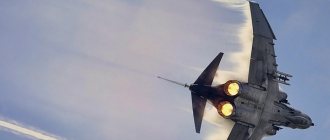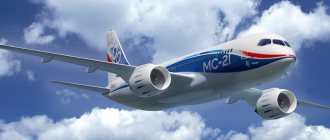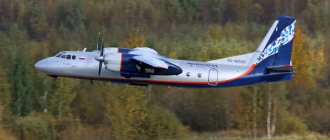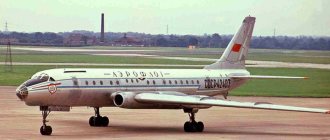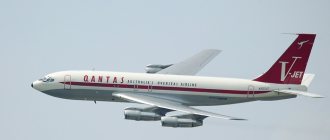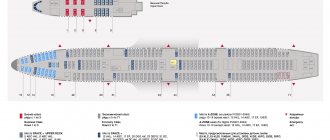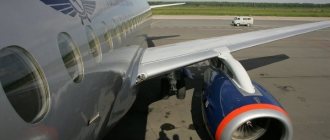The Tu-144, which according to NATO codification was called the Charger, is a supersonic Soviet passenger aircraft developed by the Tupolev Design Bureau.
Built in the 1960s, it was the first supersonic airliner to be operated by airlines for commercial air travel.
History of Tu-144
The first flight of the Tu-144 prototype aircraft was performed on December 31, 1968. During the creation, work was carried out simultaneously in two directions. The first implied the creation of a non-afterburning, economical turbojet engine of the RD-36-51 type, the second was aimed at improving the aerodynamic characteristics of the Tu-144.
As a result, they planned to complete the task of achieving supersonic flight. In 1969, by decision of the USSR Council of Ministers commission, the option of equipping the aircraft with the RD-36-51 power plant was adopted.
In parallel, the MGA organization made a decision to build six Tu-144s with more fuel-efficient NK-144A engines. The modernization with new engines met the requirements for the supersonic flight range of the first stage (4-4.5 thousand km); it was planned to equip production models with RD-36-51 engines.
The first pre-production modernized Tu-144 aircraft began to be assembled in 1968 at the MMZ “Experience”. According to calculated data, NK-144 engines could provide a supersonic flight range of 3275 km, and NK-144A - 3500 km.
To improve the aerodynamic characteristics of the car, the shape of the wing was changed. The degree of sweep was changed: along the leading edge it was 76°, and along the base - 57°. Unlike “044”, the wing area was increased, and intensive conical twist of the end parts of the wing was introduced. But the main thing that improved aerodynamics was the change in the central part of the wing, which ensured self-balancing in cruising speed modes. The changes affected the length of the fuselage, which could accommodate up to 150 passengers. The improvement of aerodynamic data was facilitated by reworking the shape of the forward fuselage. The twin engines along with the engine nacelles were moved apart, thereby freeing up space in the lower part of the fuselage. This arrangement entailed changes in the chassis system: the main landing gear supports were placed under the engine nacelles, and the retraction took place inside between the air ducts of the engines.
As a result of design improvements, an increase in fuel reserves and payload, the aircraft’s take-off weight increased to 190 tons (in the “044” project this figure was 150 tons).
The first pre-production copy of the Tu-144 was released at the beginning of 1971, and its first flight took place on June 1, 1971. According to the factory test program, 231 flights were carried out, 55 flight hours were completed in supersonic mode.
On September 20, 1972, the plane flew on the route Moscow - Tashkent, which was covered in 1 hour 50 minutes. During the flight, the cruising speed of the vehicle reached 2500 km/h.
Serial production of the Tu-144 airliner was established at the Voronezh Aviation Plant.
The production model, which was equipped with NK-144A engines, was first flown on 03/20/1972. Unlike the pre-production vehicle, the wing area was slightly added, which resulted in an increase in take-off weight to 195 tons.
On June 3, 1973, the first production aircraft crashed in front of 350 thousand spectators. The crew wanted to repeat the feat of the Concorde, which had performed a “fighter” maneuver the day before - to fly over the runway and take off again. However, this could not be done. Starting from an altitude of 1200 m, the plane suddenly began to dive and, only reaching 120 m above the ground, began to slowly rise. The overload far exceeded the permissible level, as a result of which first the left wing fell off, and then the tail section. The aircraft's structure was completely destroyed. The crash occurred near the small French town of Goussainville. As a result of the disaster, the entire crew of the liner and 7 local residents were killed, 28 people were injured.
The first passenger flight with the participation of the Tu-144 took place on October 1, 1977. Until May 1978, the aircraft operated 55 passenger and 47 cargo flights.
A total of 17 copies of the Tu-144 supersonic airliner were produced, 14 of which were produced in Voronezh. The equipment for the passenger compartments was ordered from the GDR. Currently, two Tu-144 aircraft are stored in the aviation museums of Monino and Ulyanovsk.
Design of the supersonic aircraft Tu - 144
Tu-144 is a Soviet supersonic aircraft developed by the Tupolev Design Bureau in the 1960s. Along with Concorde, it is one of only two supersonic airliners ever used by airlines for commercial travel.
In the 60s, projects to create a passenger supersonic aircraft with a maximum speed of 2500-3000 km/h and a flight range of at least 6-8 thousand km were actively discussed in aviation circles in the USA, Great Britain, France and the USSR. In November 1962, France and Great Britain signed an agreement on the joint development and construction of Concorde (Concord).
The Tu-144 is unlike other aircraft, and for good reason
Supersonic aircraft are structurally very different from conventional airliners with jet engines. Today we know a lot about the structure of both. But in the 60s, practically no country had such a volume of knowledge.
Many experts and amateurs often call the Tu-144 an engineering miracle, since building such an aircraft in such a short time is indeed comparable to a miracle.
The Tu-144 does not have a “tail” for altitude control. The elevons located at the end of the wing are responsible for this. The advantage of this design is the reduced weight of the airframe and less drag. A similar design was used in Concorde.
Also, the Tu-144 does not have the usual structural elements for an aircraft - flaps and slats. But near the cabin it has small wings that direct the air flow under the wings. Thanks to this, the plane landed with a lower angle of attack and at lower engine power.
Tu-144 is a huge plane. Its length is 66 meters and weighs 85 tons, excluding fuel. By comparison, it is only 7 meters shorter than the Airbus A380, the world's largest passenger airliner. At the same time, the Airbus A380 can carry a maximum of 853 passengers, while the Tu-144 is designed for only 100 passengers.
The Tu-144 was supposed to reach supersonic speed, and this required powerful engines and a large supply of fuel.
Creators of a supersonic aircraft
In the Soviet Union, the design bureau of academician Andrei Tupolev was involved in the creation of a supersonic aircraft. At a preliminary meeting of the Design Bureau in January 1963, Tupolev stated:
“Reflecting on the future of air transportation of people from one continent to another, you come to a clear conclusion: supersonic airliners are undoubtedly needed, and I have no doubt that they will come into use…”
The academician’s son, Alexey Tupolev, was appointed as the lead designer of the project. More than a thousand specialists from other organizations worked closely with his design bureau. The creation was preceded by extensive theoretical and experimental work, which included numerous tests in wind tunnels and natural conditions during analogue flights.
Concorde and Tu-144
The developers had to rack their brains to find the optimal design for the machine. The speed of the designed airliner is fundamentally important - 2500 or 3000 km/h. The Americans, having learned that the Concorde is designed for 2500 km/h, announced that just six months later they would release their passenger Boeing 2707, made of steel and titanium. Only these materials could withstand the heating of the structure when in contact with air flow at speeds of 3000 km/h and above without destructive consequences. However, solid steel and titanium structures still have to undergo serious technological and operational testing. This will take a lot of time, and Tupolev decides to build a supersonic aircraft from duralumin, designed for a speed of 2500 km/h. The American Boeing project was subsequently completely closed.
In June 1965, the model was shown at the annual Paris Air Show. Concorde and Tu-144 turned out to be strikingly similar to each other. Soviet designers said - nothing surprising: the general shape is determined by the laws of aerodynamics and the requirements for a certain type of machine.
Tu-144 is a legendary aircraft. They don't make these anymore
The Tu-144 is, of course, a very significant aircraft for world aviation. It had a short but eventful history.
Today, supersonic aircraft are used only in military aviation. Leading manufacturers are not developing supersonic passenger aircraft.
With the development of aviation, companies are opening up new directions. For example, electric planes such as Alia.
However, not everyone is ready to forget about supersonic. Aerion develops supersonic business jets. The AS2 model will be able to reach speeds of up to 1,700 km/h. Aerion has already received orders for 40 aircraft. First flights are expected in 2024–25. We wait.
( 104 votes, overall rating: 4.84 out of 5)

